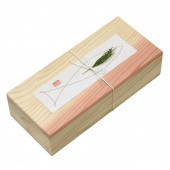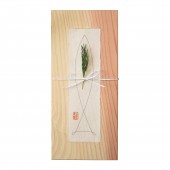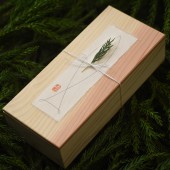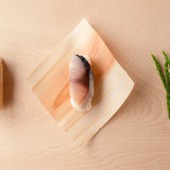DESIGN NAME:
Cedar Sushi
PRIMARY FUNCTION:
Package
INSPIRATION:
The area where this product is produced is called Keihoku, located in northern part of Kyoto, Japan, where forestry industry had thrived traditionally. However, due to the less use of domestic wood materials, the community has faced declining forestry and less job opportunities for locals.
This time, the designer has created a new symbolic product by linking forestry and traditional mackerel sushi. Sugi-sushi is a product which enables the community to re-brand the depopulated area and encourages regional revitalization.
UNIQUE PROPERTIES / PROJECT DESCRIPTION:
Cedar sushi is a mackerel sushi wrapped by a thinly sliced cedar tree. The wood box using local cedar materials is made by local forestry workers.
Historically, mackerel used to be brought from the seaside to the old capital Kyoto via Keihoku's path, and it was very precious in the deep mountains.
We have packed this treat filled with local history and culture in a cedar box and decorated with paper with a drawing of fish, and a ceder leaf. All these packaging materials are natural, and symbolize sustainable local lives.
OPERATION / FLOW / INTERACTION:
Before this project, the local community was already aware of many issues in the rural mountainous area. So the design proposal of mackerel sushi was enthusiastically welcomed by locals since this product clearly provided a solution.
Moreover, even another collaboration with community tourism section made true: international travelers now enjoy cooking mackerel sushi with the chef and learn about local / Japanese culture in depth.
PROJECT DURATION AND LOCATION:
The project started in April 2017 and completed as a designed product (started distribution in shops) in August 2017. The location was in Keihoku, northern part of Kyoto.
FITS BEST INTO CATEGORY:
Packaging Design
|
PRODUCTION / REALIZATION TECHNOLOGY:
The rural community where the designer moved has various unique specialists from each industry, but their expertise never really met a collaboration with each other. By the means of design, he tried to connect different players’ skills and appeal in one package and actualized one product which brings profit to both sides.
SPECIFICATIONS / TECHNICAL PROPERTIES:
Width 930 mm X Depth 211 mm X Height 520 mm
TAGS:
community, sustainability, social impact, local material, natural material, regional context, history, Kyoto, Keihoku, Satoyama
RESEARCH ABSTRACT:
In fact, research of the designer was to move to the community and live there on his own. While spending lots of time locally with various residents from all generations, he gradually understood about issues and possibilities of the community.
CHALLENGE:
The challenge was to have a collaboration among rural players from different (or even in the same) industry, because of the conservative and fixed human relationship in the old community.
As a designer who moved from an outside city, Kunimatsu believes that “design” should also reach designing a harmonious relationship among residents to gather cooperation and revitalize the depopulated community. By actualizing the concrete product which brings benefit to both parties mutually, he succeeded in connecting forestry workers and a sushi chef together in this project.
ADDED DATE:
2018-02-27 09:55:26
TEAM MEMBERS (1) :
IMAGE CREDITS:
Shigeki Kunimatsu, 2017.
|









